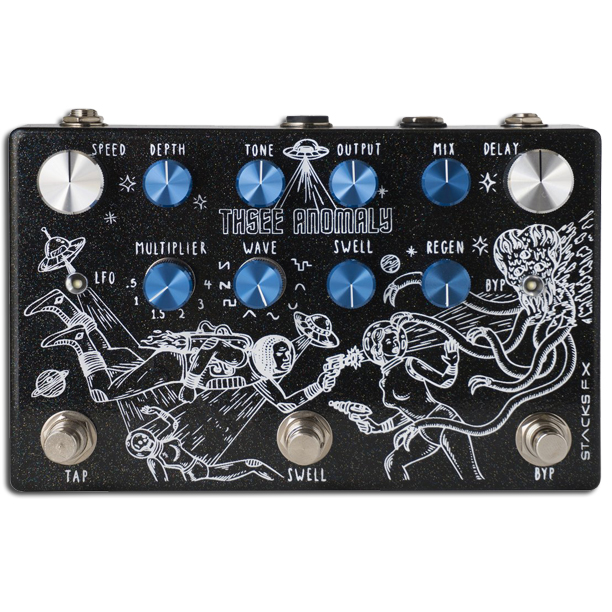
Californian Boutique pedal maker Stacks FX has released its first delay pedal, the Thsee Anomaly, and it looks and sound very intriguing indeed.
This optically controlled delay offers a fully featured LFO section (i.e. modulation) with tap tempo, six multipliers and 8 different waveforms to choose from, including the always-fun random wave. The LFO allows for a host of inspiring pitch-swinging delays, from lush chorus and vibrato to wild rising swells and “falling star”–like tones.
Thsee Anomaly Delay follows on the heels of Stacks FX’s silicon fuzz pedal, the Fuzz Gazer, which was used on the Foo Fighter’s 2018 Grammy award-winning single, “Run.”
Highlights of Thsee Anomaly include:
-
- Delay controlled via an Opto-Coupler cell opening new tonal possibilities.
- 8 waveform, 6 tap-tempo multiplier–equipped LFO section.
- Momentary swell footswitch gives an additional slap-like hold.
- Create new time-stretching delays, lush chorus, vibrato, and more.
- Expression pedal jack makes manipulating delay time a breeze.
- Entirely hand wired and handbuilt.
Thsee Anomaly Delay retails for $399.99. Like all of Stacks FX’s pedals, it’s designed and built at the company’s base of operations in Long Beach, California.
Watch the videos below for more information, and visit Stacks FX.
Manufacturers Notes
Thsee Anomaly is an optically controlled delay which offers an incredibly robust LFO section with Tap Tempo and 6 multipliers.The LFO allows for a whole host of inspiring pitch swinging delays, from lush chorus and vibrato to wild rising swells and falling star-like tones.
A lot of digital delays use PT2399 chips. PT2399 are great delay chips for shorter delay times in most instances. However, the longer you try and push the delay time, the more the signal degrades and artifacts, creating some really gnarly sounds. A lot of companies might avoid this. We f**king embraced it.
Why?
Cause it sounds really cool the way we did it.
Imagine you plugged your guitar using a really long cable and then threw that cable into a worm hole. You then mic up the wormhole with a Shure SM57 (cause it will survive) and BAM. Thats what the delay can sound like.
Here’s why.
Instead of a standard potentiometer controlling the delay time, we have a photo-coupler cell.. typically found in tremolo, vibrato, and optical compressors (such as the Teletronix / Universal Audio LA2A).
The photo-coupler cell is paired up to a light source. In this case, an LED. That LED is fed power from the LFO section, specifically the Depth pot. If the depth is all the way down, there is no LFO and the light stays constant. Once you start to adjust the depth, however, the voltage fed to the LED varies, causing the LED to flash. This changes how much light the photo-couple cell receives, and ultimately changes how much resistance is fed to the delay control.
The result are unique and interesting delays.






















